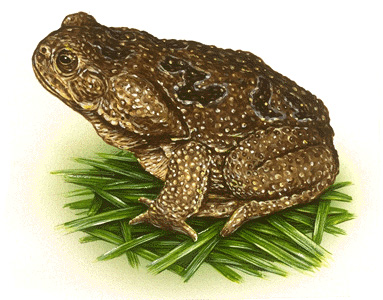Cane toad is one of the largest toads. Cane toads measure about 9 inches (23 centimeters) long and weigh about 3.3 pounds (1.5 kilograms). They are found chiefly in tropical America. The cane toad is also called the marine toad and the giant toad.

The cane toad may be gray, olive-brown, reddish-brown, or yellowish in color with dry, warty skin. It prefers open habitats and is often found in farmlands and populated areas. Cane toads feed mainly on insects but will eat almost any kind of small animal, including frogs, lizards, snakes, mice, and birds. A pair of large parotoid glands on top of the toad’s head secrete poisonous substances. These substances taste bad and can sicken or even kill animals that eat the cane toad. The cane toad is one of the most poisonous toads on Earth.
Female cane toads can produce up to 35,000 eggs at one time. The eggs are laid in long strands that look like dark dots in clear jelly. Tadpoles hatch in 1 to 3 days. The cane toad can live up to 10 years.
Loading the player...Cane toad
Human activities have introduced the cane toad into many places, including Australia, the Caribbean Islands, Hawaii, Japan, New Guinea, and the Philippines. The cane toad has become a serious pest in Australia. It was brought there in 1935 to help control beetles that attack sugar cane. Since then, the cane toad population in Australia has increased dramatically. Conservationists are concerned that many animals native to Australia may become extinct as cane toads compete with them for food, feed on them directly, and poison predators (hunting animals).
